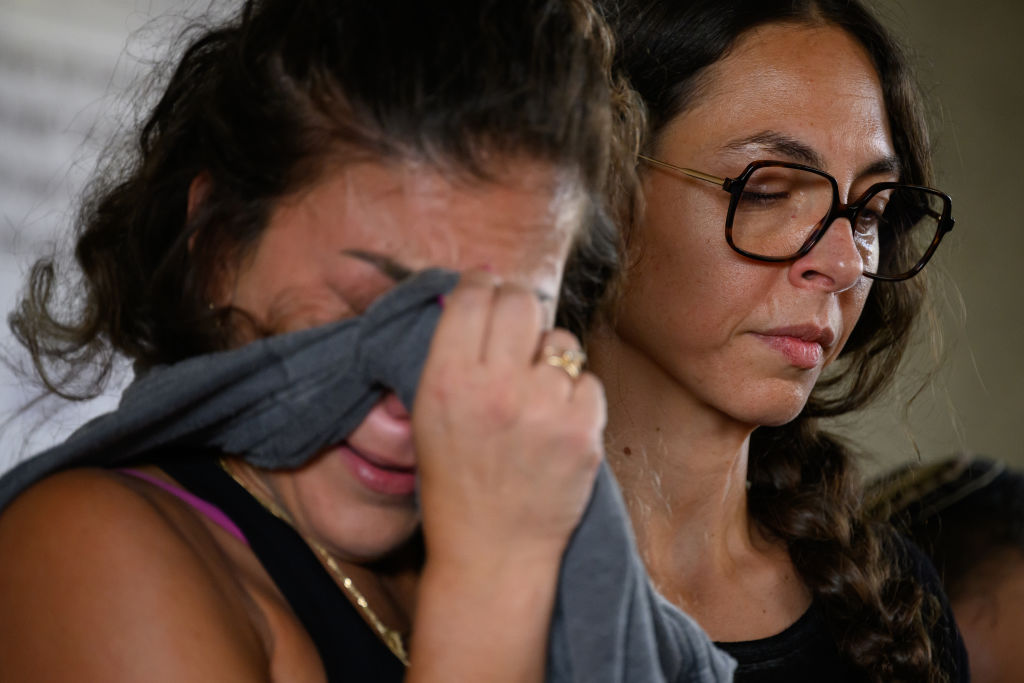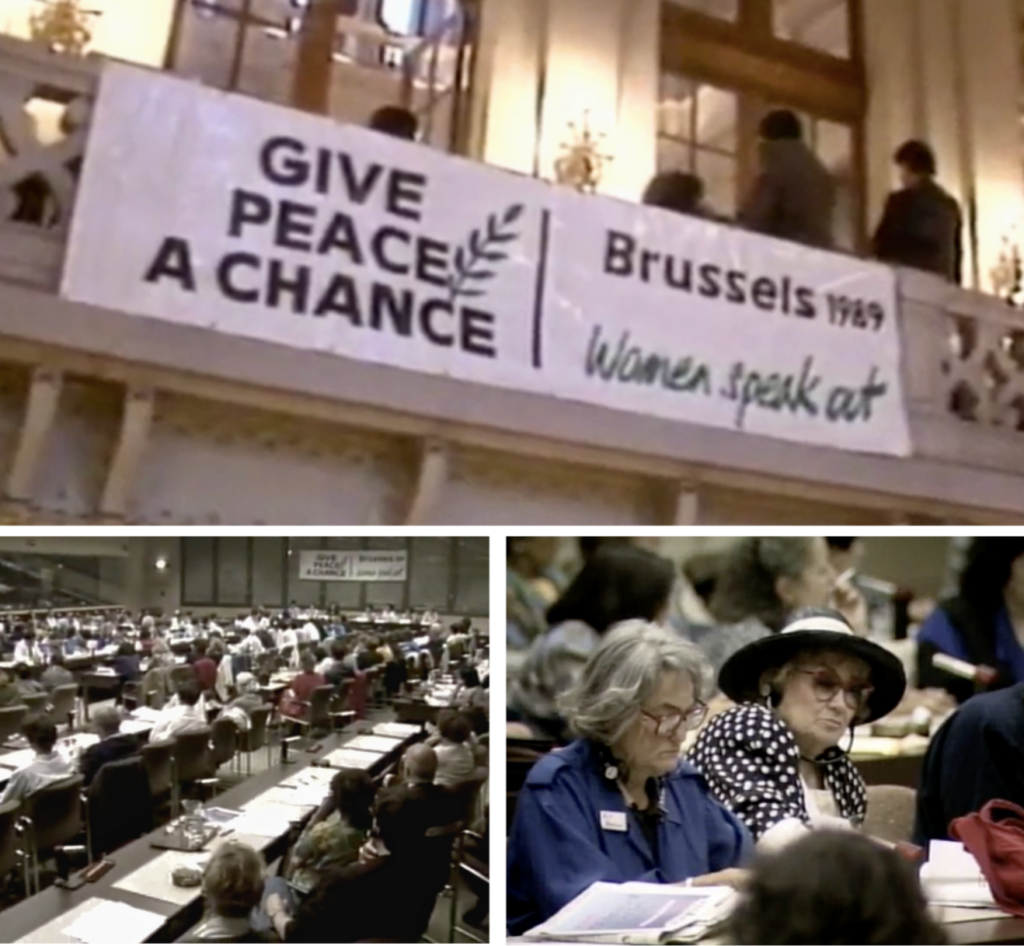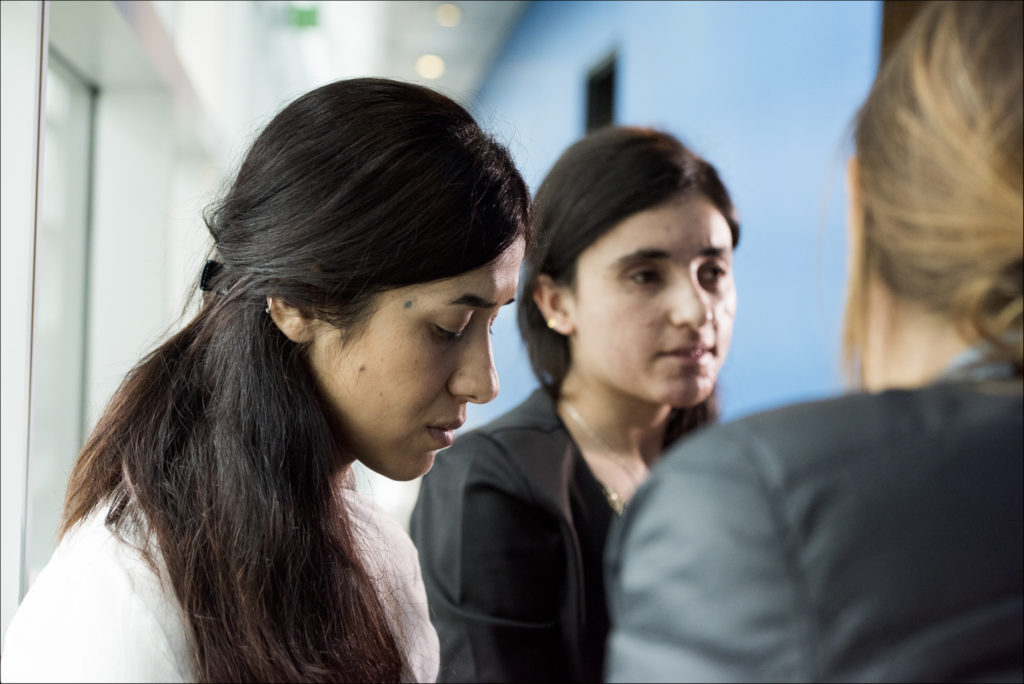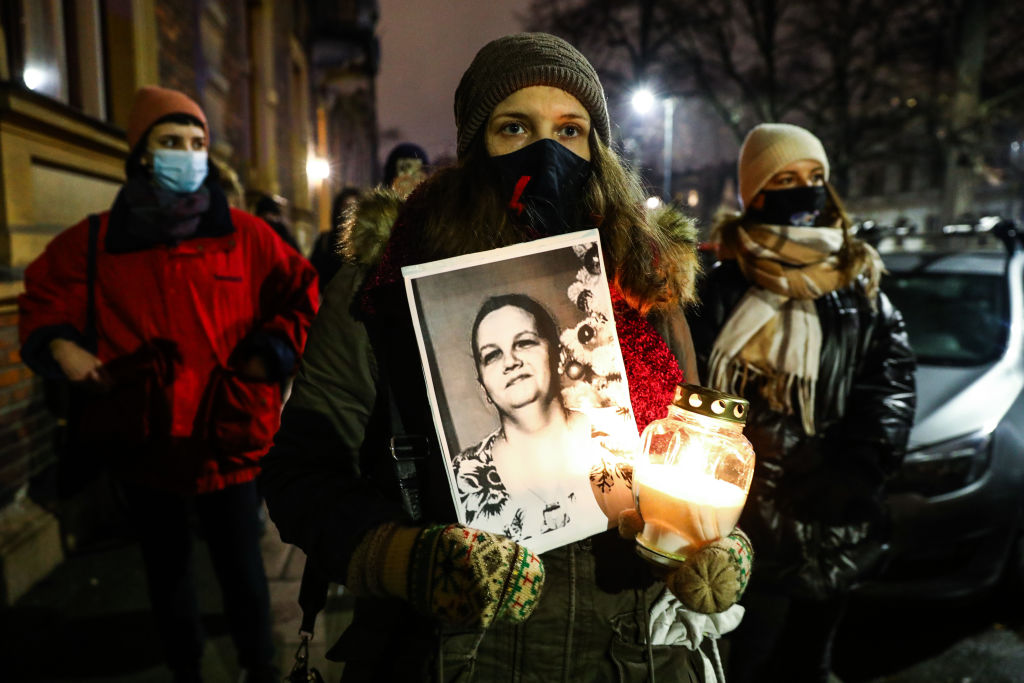Feminists have long been sounding the alarm on the use of rape as a weapon of war—and firsthand accounts of what happened in Israel on Oct. 7 are spurring an urgent conversation once again, reminding us that the battle to secure justice for the victims of rape through war crimes prosecutions continues to this day. Sexual violence as a tactic of war plagues women all over the world—from the Congo, to Ethiopia, to Yemen, to Syria, to Ukraine.
Below, we’ve curated some Ms. reporting from the last decade, to put in context for readers the feminist fight to designate rape as a war crime and a crime against humanity.
Note: This content contains graphic descriptions of sexual violence that may be disturbing for some readers.
Global News: Israel
Ms. Winter 2024 issue, by Camille Hahn.

When hundreds of Hamas terrorists tore through Israeli communities and military bases on Saturday, Oct. 7, they murdered approximately 1,200 people, at least 846 of them civilians, and took about 240 people hostage, including children. The bodies of some women and girls who were murdered bore evidence of brutal treatment—rape and gang-rape, torture and mutilation. Photos shared online show women hostages being paraded through Gaza’s streets, “blood gushing from between their legs,” according to the online magazine Tablet. And The New York Times reported, in video footage taken from body cameras worn by the attackers and compiled by the Israeli military “victims are seen gagged and with their hands bound behind their backs. Faces are frozen in shock and agony. Women’s bones are broken, their legs twisted in impossible angles.”
At a conference this week at the United Nations headquarters in New York, people who witnessed the horrors shared harrowing firsthand accounts. Yael Richert with the Israeli national police shared this account from an unidentified survivor of the Oct. 7 music festival:
Everything was an apocalypse of corpses. Girls without any clothes on. Without tops. Without underwear. People cut in half. Butchered. Some were beheaded. There were girls with a broken pelvis due to repetitive rapes. Their legs were spread wide apart, in a split.
Shari Mendes of the Israel Defense Forces said:
It seems as if the mutilation of these women’s faces was an objective in their murders.
Simcha Greinman, an emergency medical worker, recalled:
I was called into a house, told there were a few bodies there, and I walked into the house. I saw in front of my eyes a woman; she was naked. She had nails and different objects in her female organs. Her body was brutalized in a way that we cannot identify her, from her head to her toes.
‘Women, War and Peace’: Rape as a Weapon of War
October 2011, by Natalie Wilson.
There are people who think that crimes against women are less important.
Peggy Kuo
The five-part series Women, War and Peace, was executive-produced by Abigail Disney, Gini Reticker and Pamela Hogan. Wilson interviewed Peggy Kuo, a war-crimes prosecutor featured in “I Came To Testify,” the first segment to air, which focuses on the first-ever international criminal tribunal that addressed rape as a weapon of war.
Addressing the case of Muslim women and girls enslaved and raped repeatedly by Serb forces in the city of Foca, Bosnia, in 1992, the landmark tribunal led to international laws defining rape as a crime against humanity
Ms.: How did you get involved in the Foca rape case?
Peggy Kuo: I was working as a prosecutor at the Justice Department in the civil rights division. I had always been interested in international law, but the opportunity had never presented itself to get involved. After the war crimes trials in Nuremburg and Tokyo, there was never another international criminal tribunal. When I heard the Yugoslavia Tribunal was being set up, I knew I had to go. The Foca case happened to be gearing up when I got there, and that is the case I was assigned to.
Why do you think it took so many years for such a tribunal to come about?
Kuo: A lot of organizations had been working on the idea of having international justice for a long time. The Yugoslavia conflict in the early ’90s became a flashpoint. A lot of things came together, including the women’s movement and the media. The reports of atrocities resonated with a lot of people, especially because many of the images that came out harkened back to the Nazi concentration camps. That galvanized people who were already working on this. ….
How is sexism contributing to our inability to stop rape as a weapon of war?
Kuo: Not everyone in the world believes that rape is serious. And I also think that there are people who think that crimes against women are less important. That layer makes it more difficult to address the problem.
Kuo closed with an important reminder about the importance of women’s involvement in the wider conversations about war and peace-building:
“When women leave the table, the issues don’t always remain there. Sometimes the issues sink to the bottom if no one is keeping them afloat. You may feel like you’re being a pain in the neck, but you just have to keep at it.”
Violence Is Not Inevitable: How U.N. Sanctions Can Prevent Rape and Sexual Assault in Armed Conflict
April 2018 by Georgetown Institute for Women, Peace and Security.
Widespread and horrific sexual violence is not an inevitable part of conflict.
Reports from Syria, Libya and Myanmar have documented the ongoing use of sexual violence as a weapon of war. They reveal the same patterns: widespread sexual violence and rape used as a tool for genocide and ethnic cleansing—aimed to humiliate, dominate and instill fear in communities and perpetrated to forcibly displace civilians in order to redraw ethnic boundaries or control areas rich in natural resources.
This is not new. We saw similar patterns of sexual violence used as a tactic of war during conflicts in Rwanda and Yugoslavia. And although for many years, sexual violence in conflicts went unnoticed, unmentioned and unpunished, the United Nations recognized in 2008 that sexual violence used as a tactic of war against civilian populations can significantly worsen hostilities and impede peace. That recognition led the United Nations Security Council to provide for the use of targeted sanctions, one of the Chapter VII coercive measures, against those who engage in such violence—a groundbreaking shift in the treatment of conflict-related sexual violence by the international community. ….
Unfortunately, there is still a long way to go. Political considerations within the Security Council often spoil or paralyze the design and use of targeted sanctions. Member states have differing opinions on whether sexual violence is a priority in dealing with conflicts or not; Russia, China and various other elected members such as India and Pakistan are also often reluctant to use coercive measures against governments, especially when they consider these governments legitimate in their fights against armed groups and rebel movements. The Security Council also faces competing objectives, some of which receive priority over sexual violence—for example, support of mediation efforts. …
Widespread and horrific sexual violence is not an inevitable part of conflict. If the Security Council begins to use sanctions consistently and systematically targets key perpetrators, they can prevent, curb or end sexual violence in conflicts around the world—and fight the impunity of those tolerating or ordering it.
Every mother, Jewish and Arab, gives birth to her children to see them grow and flourish and not to bury them.
Women Wage Peace
In Ms. Winter issue, Hahn continues:
In the ensuing war in Gaza, women and children account for 67 percent of those who have died, U.N. agencies reported in early November. Some 180 women give birth in Gaza every day, but when birth complications occur, they are unable to access emergency care. “Some women are having to give birth in shelters, in their homes, in the streets amid rubble, or in overwhelmed healthcare facilities, where sanitation is worsening, and the risk of infection and medical complications is on the rise,” the World Health Organization reports.
“The vast majority of people who are suffering from this war are women and their children,” feminist author Jill Filipovic wrote. “The vast majority of decision-makers and violence-purveyors on both sides of this current war are men who have long made clear they have little interest in women’s rights, freedoms or even basic safety.”
Nearly 35 years ago, Israeli and Palestinian women gathered in Brussels for the first Women’s Peace Conference. According to journalist and media executive Pat Mitchell, who was a witness to the gathering, “These women put aside their differences to draft a seven-point agreement that would have provided a plan for a peaceful, secure future for Israel and the Palestinians. But regrettably, without enough women in either the Knesset or in the Palestinian Authority leadership at the time, the agreement was never given serious consideration.”

Founded in 2014, the Jewish and Arab Israeli coalition, Women Wage Peace continues the call for a peaceful resolution to the conflict and for women to be included in negotiations and decision-making. “Every mother, Jewish and Arab, gives birth to her children to see them grow and flourish and not to bury them,” the coalition wrote on Oct. 15. “That’s why, even today, amidst the pain and the feeling that the belief in peace has collapsed, we extend a hand in peace to the mothers of Gaza and the West Bank. We mothers, together with women from all over the world, must unite to stop this madness.”
In November one of the co-founders of Women Wage Peace, Canadian Israeli activist Vivian Silver, was confirmed dead by Israeli authorities. She was killed in Hamas’ initial attack, but her body was not discovered in early searches of the burned ruins of her home. For a month, friends and family believed she might be among those held hostage in Gaza.
“Vivian is sitting on my shoulder from now on,” Yael Braudo-Bahat, a co-director of Women Wage Peace, told The New York Times after learning of Silver’s death. “I’m going to apply all of the things I learned from her so that there will be peace here.”
(Join the Ms. community today and you’ll get the Winter issue delivered straight to your mailbox.)
Combating Terrorism and Misogyny Together
November 2023, by Annie Pforzheimer and Shabnam Nasimi:
In the grim landscape of global conflict, one element stands starkly at its core: the systematic oppression and subjugation of women. ISIS, Hamas and the Lord’s Resistance Army in Uganda use rape as a weapon of war. The resurgence of the Taliban demonstrates what an extremist terrorist group will do with an entire country: create a brutal reality where misogyny is not a byproduct but a fundamental pillar of extremist ideology. Extremists in Europe and the United States conduct deadly, misogyny-fueled lone wolf attacks.
The narrative of international security and foreign policy ignores gender, overlooking the crucial role women play in the fabric of societal stability. Even after 2000, even with the United Nations Security Council’s Resolution 1325 on Women, Peace and Security, the world only fitfully recognizes gender-based violence in armed conflict as a critical issue.
What Nadia Murad’s Nobel Peace Prize Means for War-Time Rape Survivors Around the World
October 2018, by Kohinur Khyum Tithila.

Women, in particular, have suffered greatly as they have been, and continue to be the victims of sexual violence.
Nadia Murad
Amal Clooney has remarked that Nadia Murad defied the labels life gave her—orphan, rape victim, refugee, slave—and instead created new ones—among them survivor, leader, advocate and author. Now, she has garnered one more: Nobel Peace Prize Winner. …
When Murad escaped from an ISIS stronghold in Mosul, BBC journalist Nafiseh Kohnavard told her they would film her anonymously, to protect her identity, so that she could tell her story and shine light on the global crisis facing her small village. She refused—because she wanted the world to see what happened to them. She did not want to be covered with shame. She refused to let her stories to be echoed within the wall of silence.
Murad’s ultimate act of defiance is that she refused to let ISIS silence her indomitable human spirit. She went on to become a UN Goodwill Ambassador and testify before the global body multiple times about the atrocities she faced. She demanded more from world leaders who stood idly by as Yazidis suffered at home and abroad, in refugee camps where they often felt forgotten.
Even in accepting the Nobel Prize, Murad saw a teaching moment. “I am grateful for this opportunity to draw international attention to the plight of the Yazidi people who have suffered unimaginable crimes since the genocide by Daesh [IS], which began in 2014,” she said in a statement. “Many Yazidis will look upon this prize and think of family members that were lost, are still unaccounted for, and of the 1,300 women and children, which remain in captivity. Like many minority groups, the Yazidis have carried the weight of historical persecution. Women, in particular, have suffered greatly as they have been, and continue to be the victims of sexual violence.”
Eyes on Everywhere Else: Sudan, Pakistan, Nagorno-Karabakh, Eastern Congo
November 2023, by Jill Filipovic.
The brutal war in Gaza has understandably captured the world’s attention, including mine. But, unfortunately, human suffering isn’t confined to a narrow strip of land on the Mediterranean. …
In eastern Congo, millions of people have been displaced and tens of thousands of women have been raped in the latest convulsions of violence in the region, fueled by the Rwanda-backed M23 militia group. In the meantime, the U.S. government is still deporting people back to Congo, a move that many U.S. faith-based groups are asking the Biden administration to halt. …
In Sudan, there’s another round of atrocities happening in Darfur, where Arab militias began a well-documented genocide two decades ago that left some 300,000 people dead. …
In Pakistan, Afghan refugees are being forcibly expelled—sent back to live under the brutalities of the Taliban, who are little more than a band of misogynist fundamentalists dead set on making life in Afghanistan as soulless and difficult as possible. …
In the Nagorno-Karabakh region, a majority-Armenian and long-contested area within Azerbaijan, an occupation by Azerbaijan forced some 100,000 people—80 percent of the population—to flee to Armenia. Armenians are mostly Christian, and are an ethnic minority in majority-Muslim Azerbaijan. … War broke out in 2020, and the region has not stabilized since (the Crisis Group has a very good and much more detailed explainer you should read). The Armenian government is calling the latest incursion an ethnic cleansing.
Poland’s Near-Total Abortion Ban Threatens Ukrainian Refugees
July 2022 by Hannah Phelps.

Refugee women—including those who have experienced sexual violence at the hands of Russian soldiers—are struggling to access abortions. …
According to Poland’s health ministry, the country has never allowed more than three abortions per year for pregnancies resulting from rape. Those seeking an abortion need to prove they were raped with a certified letter from a public prosecutor.
Krystyna Kacpura, president of the Federation for Women and Family Planning (Federa), a Polish reproductive rights organization, said to receive the certified letter from a public prosecutor, details such as the time, date and location are necessary. “For Ukrainian women who were raped by Russian soldiers, this is impossible. And anyway, many of them are so traumatized that they will not speak about it at all—not even with us.”
Thus, abortion is virtually impossible within Poland.
In crises such as the Russian invasion of Ukraine, women disproportionately face sexual and gender-based violence. Although the exact number of cases involving sexual abuse in the Russian-Ukrainian conflict is unknown, Matilda Bogner, a U.N. human rights investigator in Ukraine, said there are “dozens of allegations,” and many of these reports occurred in “the areas around Kyiv where Russian forces were and then left.” As of early June 2022, U.N. officials received more than 120 reports of rape, though they believe the number to be much higher.
In response to this humanitarian emergency, United Nations High Commissioner for Refugees (UNHCR) officials are demanding refugees in Poland have access to reproductive rights, including abortion. This echoes the call made by some Polish politicians earlier this year for the national government to guarantee all refugees the right to abortion in a public hospital. While the attention of the international community is on abortion access in Poland, no change has yet been made to ease restrictions for Ukrainian refugees. As the war continues, the need for emergency contraception and abortion services will continue to grow exponentially.
Up next:
U.S. democracy is at a dangerous inflection point—from the demise of abortion rights, to a lack of pay equity and parental leave, to skyrocketing maternal mortality, and attacks on trans health. Left unchecked, these crises will lead to wider gaps in political participation and representation. For 50 years, Ms. has been forging feminist journalism—reporting, rebelling and truth-telling from the front-lines, championing the Equal Rights Amendment, and centering the stories of those most impacted. With all that’s at stake for equality, we are redoubling our commitment for the next 50 years. In turn, we need your help, Support Ms. today with a donation—any amount that is meaningful to you. For as little as $5 each month, you’ll receive the print magazine along with our e-newsletters, action alerts, and invitations to Ms. Studios events and podcasts. We are grateful for your loyalty and ferocity.





